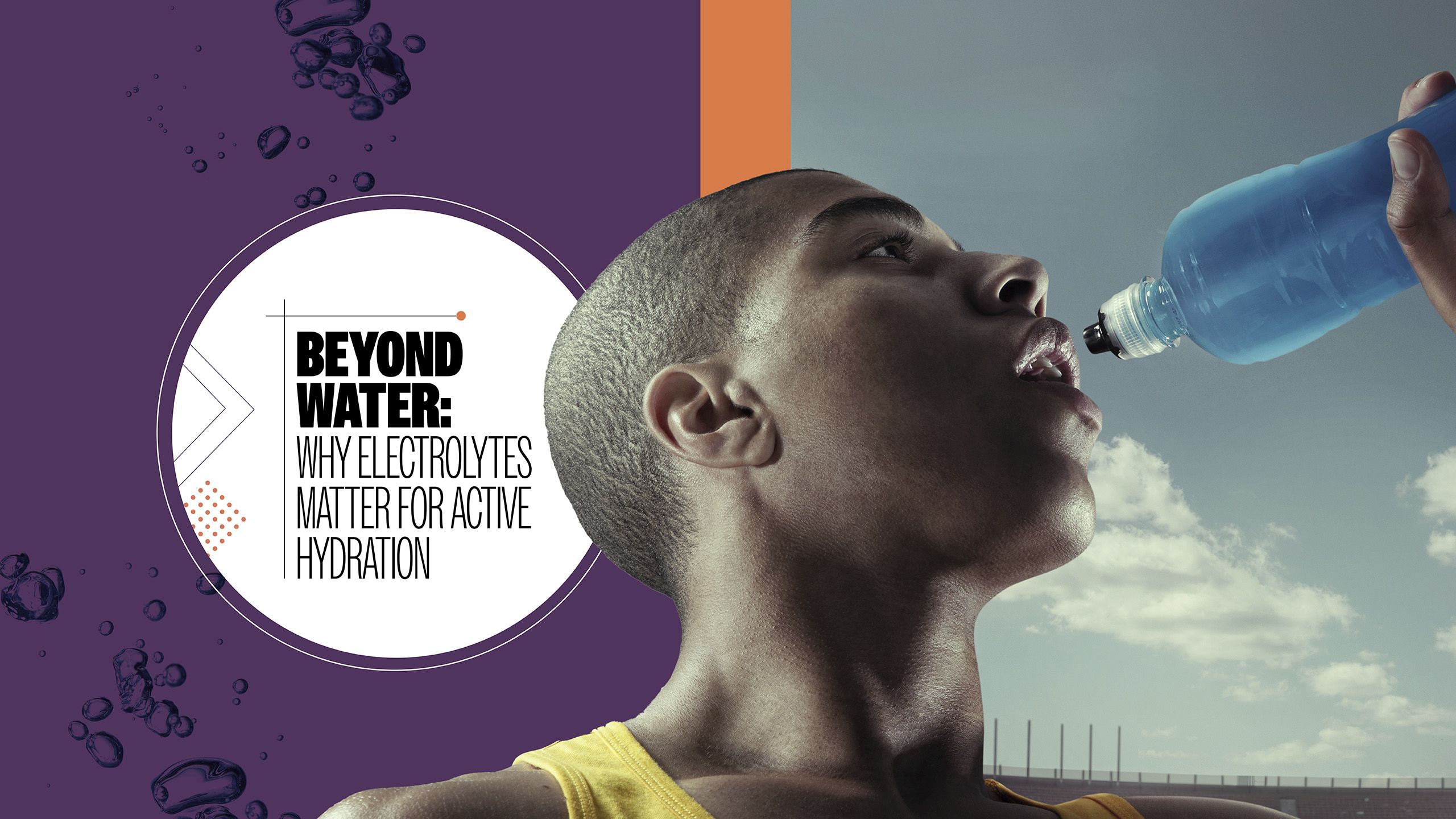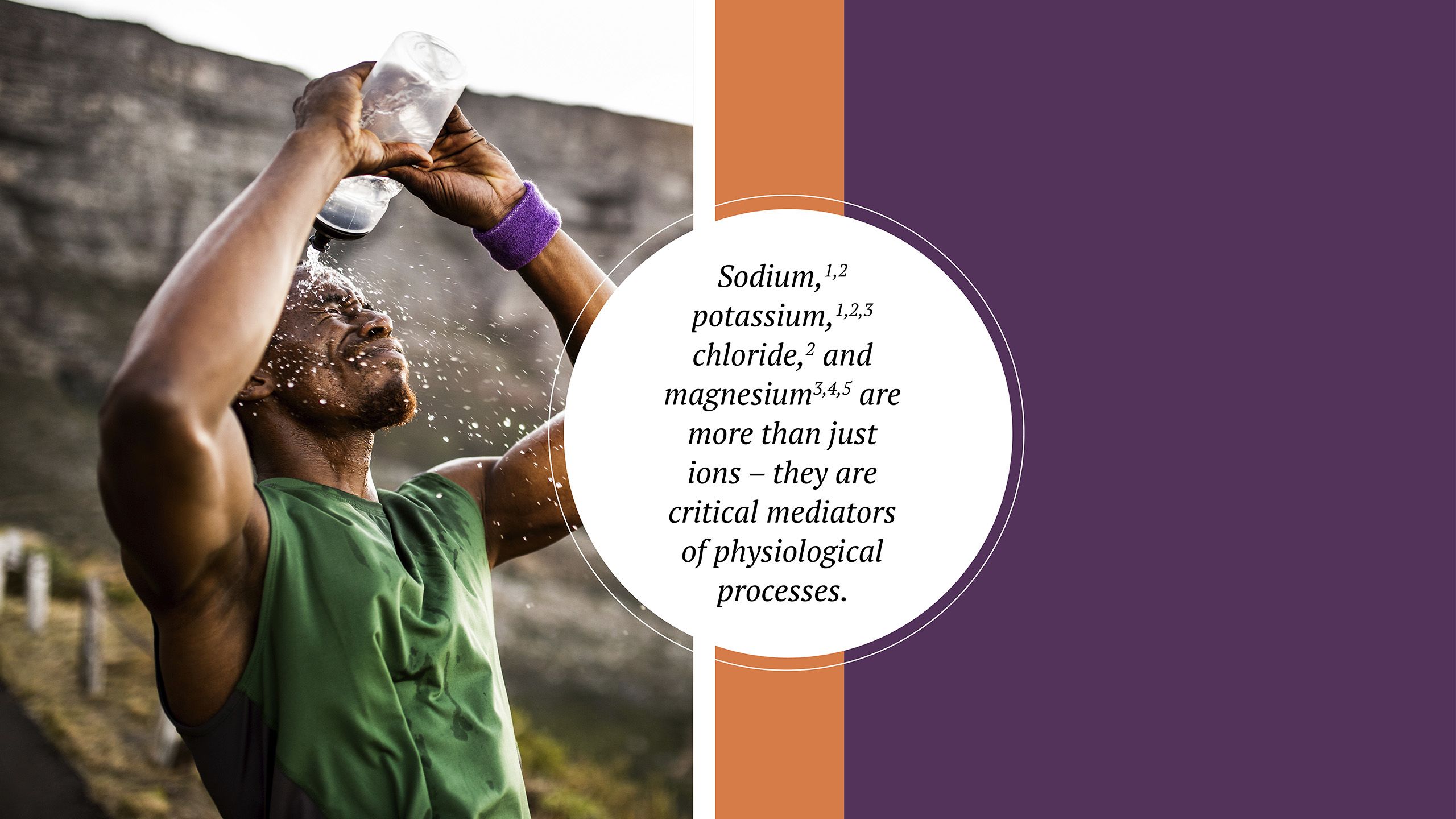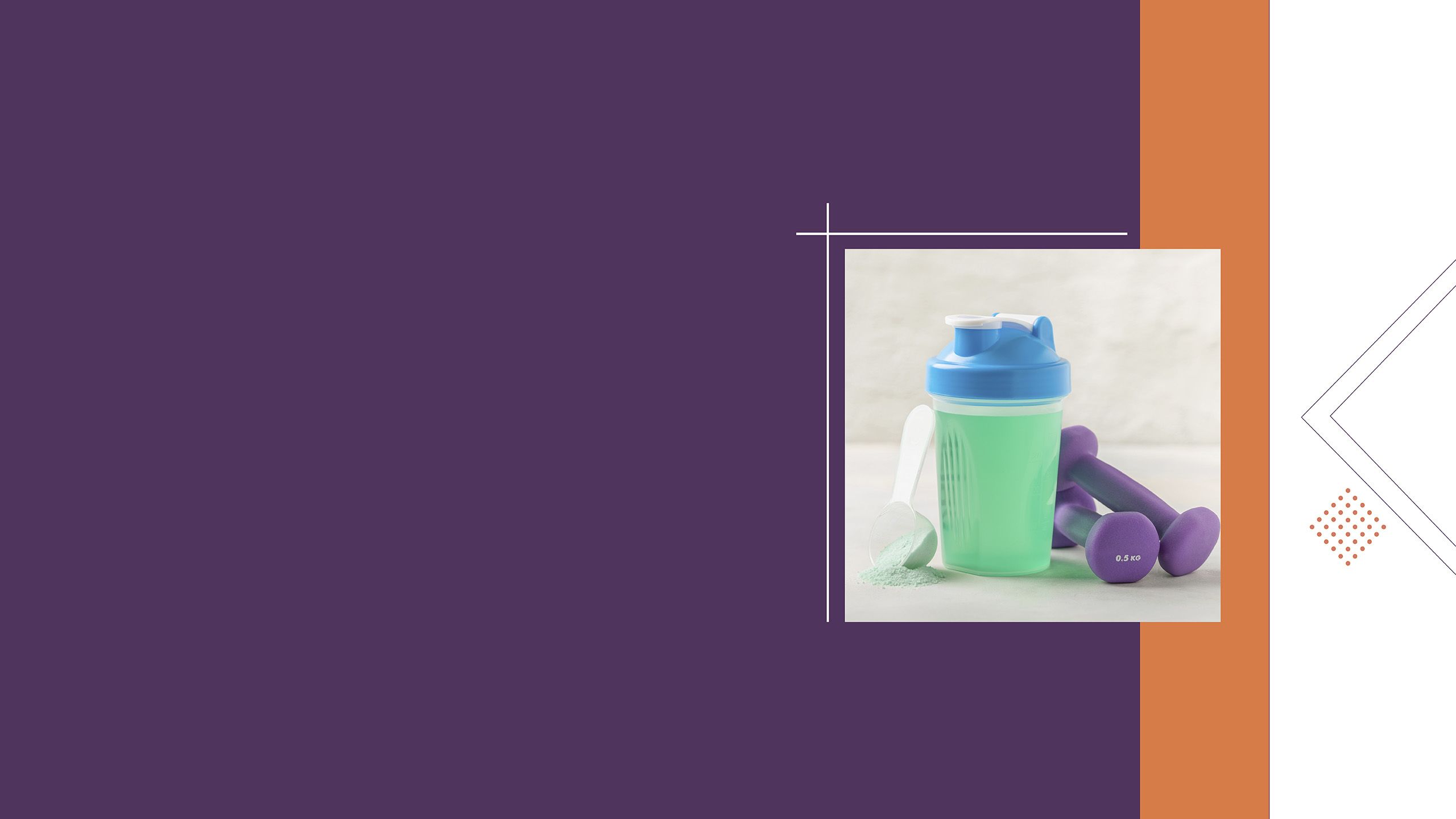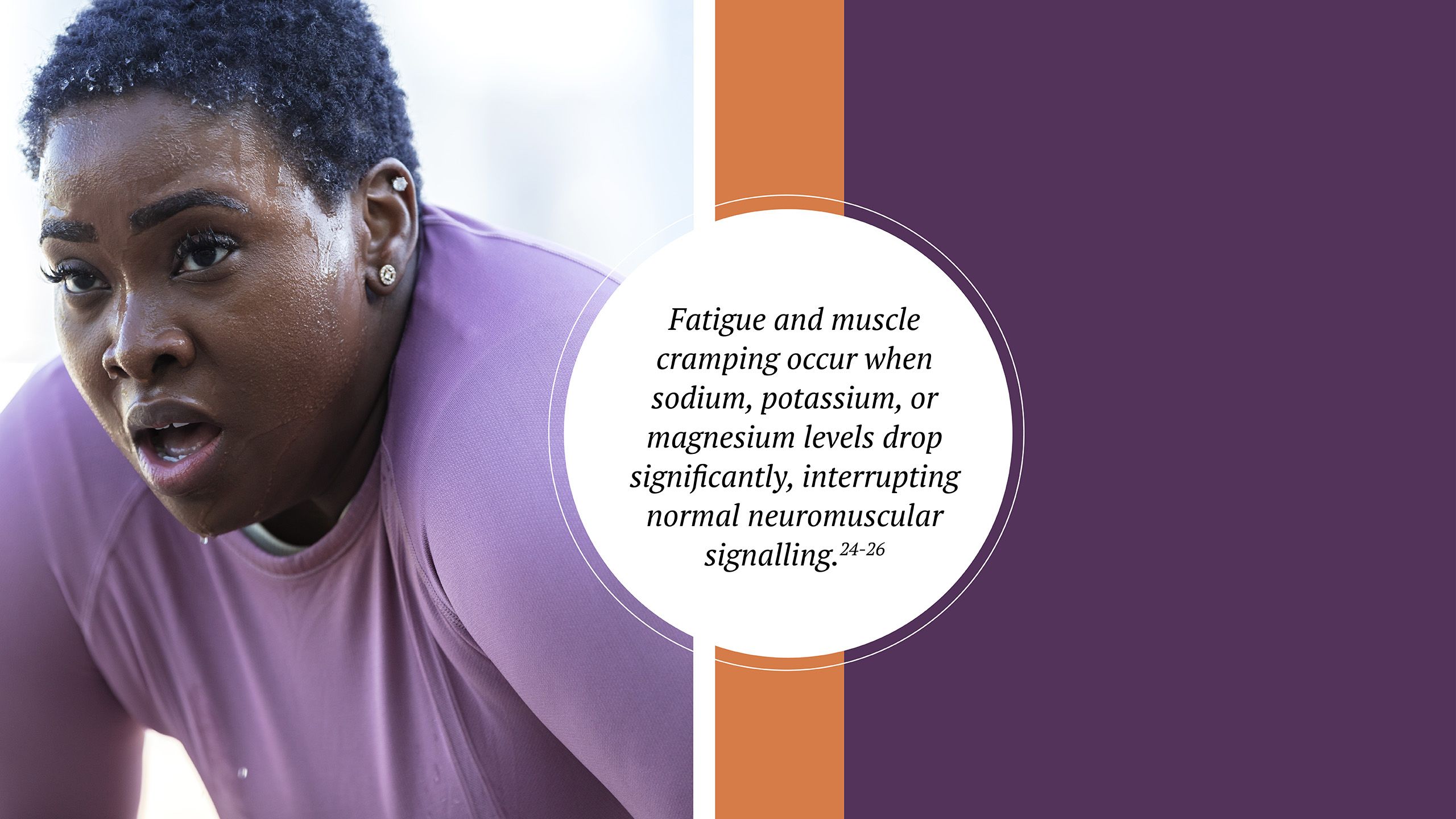
Understanding the intricate roles of electrolytes in hydration and recovery is essential. Sodium,1,2 potassium,1,2,3 chloride,2 and magnesium3,4,5 are more than just ions – they are critical mediators of physiological processes. These electrolytes maintain bodily hydration, muscle contraction, and nerve function, making them vital for active individuals prone to fluid and electrolyte loss through exercise and perspiration.2,4,5 This article delves into the science behind electrolytes and the importance of replenishing them to promote optimal hydration and prevent exercise-induced complications.


FLUID AND ELECTROLYTE LOSS DURING EXERCISE
Exercise, particularly in hot and humid conditions, significantly increases perspiration rates.2,6 Sweat is composed of water and key electrolytes, with sodium being the most abundant.7,8 Sodium losses in sweat can vary widely, typically ranging from less than 200 mg/L to over 2 300 mg/L, with an average of approximately 950 mg/L in athletes. During prolonged physical activities, such as marathons or soccer, total sodium losses may reach significant levels depending on sweat rate and environmental conditions.9 Potassium, magnesium, and chloride are lost in smaller quantities but remain equally critical for physiological balance.10,11
The depletion of sodium and other electrolytes during exercise leads to a series of systemic disruptions.2,12,13 Sodium deficits, for instance, impair plasma osmolality and reduce extracellular fluid volumes, resulting in diminished blood pressure and cardiovascular strain.14 Hypohydration, characterised by a net body water loss, compounds these effects, reducing plasma volume and impairing thermoregulation. If unaddressed, this can result in fatigue, reduced performance, muscle cramps, or even life-threatening heatstroke.15-17




PHYSIOLOGICAL ROLE OF ELECTROLYTES
Electrolytes perform distinct yet complementary roles to ensure muscles, nerves, and various homeostatic systems function effectively:3,18-20
• Sodium: Sodium is the primary extracellular cation, crucial for regulating fluid balance, blood pressure, and nerve conduction. It facilitates muscle contraction by creating an electrical gradient critical for action potentials in skeletal and smooth muscles.3
• Potassium: Potassium is a vital nutrient and mineral that plays a fundamental role in supporting cellular functions, contributing to processes such as muscle contraction, nerve function, fluid balance, and maintaining proper heart rhythm.21-23
• Chloride: A major extracellular anion, chloride works with sodium to maintain osmotic equilibrium. It plays a role in gastric hydrochloric acid production and supports nerve signal propagation by stabilising neuronal resting potentials.19
• Magnesium: Magnesium is indispensable for over 300 biochemical reactions, including energy production (ATP synthesis) and calcium regulation. Its role in muscle relaxation and contraction prevents prolonged contraction, reducing cramp susceptibility.3,5
IMPACTS OF ELECTROLYTE IMBALANCES
Electrolyte deficiencies can have cascading effects. Fatigue and muscle cramping occur when sodium, potassium, or magnesium levels drop significantly, interrupting normal neuromuscular signalling.24-26 Sodium imbalances can impair muscle function by disrupting the depolarization phase of action potentials, reducing excitability and interfering with effective contraction, particularly in skeletal muscle.27-29 Low magnesium interferes with calcium uptake, promoting involuntary contractions and increasing muscle fatigue.5
If left uncorrected, imbalances may result in:
• Heat exhaustion or heatstroke: Marked by confusion, nausea, and even seizures due to severe dehydration and electrolyte depletion.30
• Cardiovascular strain: Caused by drops in blood pressure and increased heart rate due to reduced blood volume.31
• Physical performance declines: Even mild dehydration leads to increased perceived exertion, slower decision-making, and impaired motor skills.32
RESTORING ELECTROLYTE BALANCE: PRACTICAL STRATEGIES
Pharmacists play an important role in educating active populations on reversing electrolyte and fluid deficits. Oral Rehydration Solutions (ORS), formulated with balanced ratios of sodium, potassium, chloride, and glucose, represent gold-standard alternatives to water-only rehydration.33 Sodium facilitates water reabsorption through intestinal sodium/glucose cotransporters,34 while potassium supports intracellular rehydration.35 Glucose enhances electrolyte transport and replenishes lost energy stores.36,37
Tips for effective hydration:
• Prehydrate: Encourage athletes to begin exercise in an adequately hydrated state by consuming electrolyte-rich drinks 2-3 hours pre-activity.38
• Intra-workout rehydration: Suggest ORS or electrolyte tablets instead of plain water for activities exceeding 60 minutes.2
• Post-exercise recovery: Prioritise rehydration immediately post-exercise, aiming to replace 150% of fluid losses within six hours.40
• Custom hydration plans: Use sweat analysis for tailored fluid and electrolyte replacement strategies, particularly for athletes engaged in high-intensity sports or training in extreme climates.7
Electrolytes are indispensable for preserving fluid balance, enabling neuromuscular communication, and optimising athletic performance.3,18,41 Pharmacists are pivotal in guiding active individuals on how to replenish these vital ions during physical exertion. Customised hydration strategies that incorporate electrolyte-rich solutions can prevent fatigue, cramps, and performance declines while mitigating health risks such as heat exhaustion. By bridging the gap between exercise physiology and individualised care, pharmacists can empower athletes to achieve their performance goals safely and sustainably.
REFERENCES
- Gnanasigamani M, Arslan E, Soylu Y, et al. Mapping Multi-Modal Fatigue in Elite Soccer Through Sweat-Omics Perspectives: A Narrative Review. Biology (Basel). August 2025. Available from: https://pmc.ncbi.nlm.nih.gov/articles/PMC12383715/. Accessed: September 2025.
- Peden DL, Funnell MP, Reynolds KM, et al. Post-exercise rehydration: Comparing the efficacy of three commercial oral rehydration solutions. Front. Sports Act. Living. April 2023. Available from: https://www.frontiersin.org/journals/sports-and-active-living/articles/10.3389/fspor.2023.1158167/full. Accessed: September 2025.
- Shrimanker I, Bhattarai S. Electrolytes. StatPearls [Internet]. January 2025. Available from: https://www.ncbi.nlm.nih.gov/books/NBK541123/. Accessed: September 2025.
- Pellicer-Caller R, Vaquero-Cristóbal R, González-Gálvez N, et al. Influence of Exogenous Factors Related to Nutritional and Hydration Strategies and Environmental Conditions on Fatigue in Endurance Sports: A Systematic Review with Meta-Analysis. Nutrients. June 2023. Available from: https://pmc.ncbi.nlm.nih.gov/articles/PMC10305101/. Accessed: September 2025.
- Jahnen-Dechent W, Ketteler M. Magnesium basics. Clin Kidney J. February 2012. Available from: https://pmc.ncbi.nlm.nih.gov/articles/PMC4455825/. Accessed: September 2025.
- Sekiguchi Y, Adams WM, Hosokawa Y, et al. Customizing individual heat mitigation strategies to optimize performance in elite athletes. Front. Physiol. April 2025. Available from: https://www.frontiersin.org/journals/physiology/articles/10.3389/fphys.2025.1380645/full. Accessed: September 2025.
- Baker LB. Sweat Testing Methodology in the Field: Challenges and Best Practices. Gatorade Sports Science Institute website. January 2017. Available from: https://www.gssiweb.org/sports-science-exchange/article/sse-161-sweat-testing-methodology-in-the-field-challenges-and-best-practices. Published 2020. Accessed: September 2025.
- Cleveland Clinic staff. Sweat. Cleveland Clinic. August 2024. Available from: https://my.clevelandclinic.org/health/body/sweat. Accessed: September 2025.
- Blow A, Jutley R. How to estimate how much sodium you lose in your sweat. 2025. Precision Hydration. Available from: https://www.precisionhydration.com/performance-advice/hydration/how-to-estimate-sweat-salt-loss/. Accessed: September 2025.
- Trail Runner Magazine. The Runner's Complete Guide to Electrolytes. Trail Runner Magazine. Available from: https://www.trailrunnermag.com/nutrition/race-day-nutrition-nutrition/the-runners-complete-guide-to-electrolytes/. Accessed: September 2025.
- Holmes N, Bates G, Zhao Y, et al. The Effect of Exercise Intensity on Sweat Rate and Sweat Sodium and Potassium Losses in Trained Endurance Athletes. Ann Sports Med Res. March 2016. Available from: https://www.jscimedcentral.com/jounal-article-info/Annals-of-Sports-Medicine-and-Research/The-Effect-of-Exercise-Intensity-on-Sweat-Rate-and-Sweat-Sodium-and-Potassium-Losses-in-Trained-Endurance-Athletes-4290. Accessed: September 2025.
- Armstrong LE. Rehydration during Endurance Exercise: Challenges, Research, Options, Methods. Nutrients. March 2021. Available from: https://pmc.ncbi.nlm.nih.gov/articles/PMC8001428/. Accessed: September 2025.
- Pérez-Castillo ÍM, Williams JA, López-Chicharro J, et al. Compositional Aspects of Beverages Designed to Promote Hydration Before, During, and After Exercise: Concepts Revisited. Nutrients. 2023. Available from: https://pmc.ncbi.nlm.nih.gov/articles/PMC10781183/. Accessed: September 2025.
- Najem O, Shah MM, Zubair M, et al. Serum Osmolality. StatPearls [Internet]. February 2024. Available from: https://www.ncbi.nlm.nih.gov/books/NBK567764/. Accessed: September 2025.
- Akerman AP, Tipton M, Minson CT, et al. Heat stress and dehydration in adapting for performance: Good, bad, both, or neither? Temperature (Austin). July 2016. Available from: https://pmc.ncbi.nlm.nih.gov/articles/PMC5356617/. Accessed: September 2025.
- Sawka MN, Cheuvront SN, Kenefick RW. Hypohydration and Human Performance: Impact of Environment and Physiological Mechanisms. Sports Med. November 2015. Available from: https://pmc.ncbi.nlm.nih.gov/articles/PMC4672008/. Accessed: September 2025.
- Beker BM, Cervellera C, De Vito A, et al. Human Physiology in Extreme Heat and Cold. Int Arch Clin Physiol. March 2018. Available from: https://clinmedjournals.org/articles/iacph/international-archives-of-clinical-physiology-iacph-1-001.php. Accessed: September 2025.
- National Library of Medicine. Fluid and Electrolyte Balance. MedlinePlus. Available from: https://medlineplus.gov/fluidandelectrolytebalance.html. Accessed: September 2025.
- Ernstmeyer K, Christman E. Nursing Fundamentals [Internet]. Chippewa Valley Technical College, Chapter 15 Fluids and Electrolytes. 2021. Available from: https://www.ncbi.nlm.nih.gov/books/NBK591820/. Accessed: September 2025.
- Ferreira K. Electrolyte Disorders: Understanding, Diagnosis, and Management. Perspective - Journal of Interventional Nephrology. November 2024. Available from: https://www.openaccessjournals.com/articles/electrolyte-disorders-understanding-diagnosis-and-management-18282.html. Accessed: September 2025.
- Miller K, Khatri M. What Does Potassium Do for Your Body? WebMD. February 2025. Available from: https://www.webmd.com/a-to-z-guides/what-does-potassium-do-body. Accessed: September 2025.
- Cleveland Clinic staff. Electrolytes. Cleveland Clinic. September 2021. Available from: https://my.clevelandclinic.org/health/diagnostics/21790-electrolytes. Accessed: September 2025.
- Jones J. What Does Potassium Do? Healthline. October 2024. Available from: https://www.healthline.com/nutrition/what-does-potassium-do. Accessed: September 2025.
- Souza ACR, Vasconcelos AR, Dias DD, et al. The Integral Role of Magnesium in Muscle Integrity and Aging: A Comprehensive Review. Nutrients. December 2023. Available from: https://pmc.ncbi.nlm.nih.gov/articles/PMC10745813/. Accessed: September 2025.
- Blow A. New lab-based evidence suggests electrolyte intake can help reduce cramps. Precision Hydration website. 2025. Available at: https://www.precisionhydration.com/performance-advice/hydration/sodium-intake-cramping-study/. Accessed: September 2025.
- Warren S. What really causes muscle cramps? Somatic Movement Center. May 2021. Available from: https://somaticmovementcenter.com/what-really-causes-muscle-cramps/. Accessed: September 2025.
- Gash MC, Kandle PF, Murray IV, et al. Physiology, Muscle Contraction. StatPearls [Internet]. April 2023. Available from: https://www.ncbi.nlm.nih.gov/books/NBK537140/. Accessed: September 2025.
- Wang X, Nawaz M, DuPont C, et al. The role of action potential changes in depolarization-induced failure of excitation contraction coupling in mouse skeletal muscle. eLife. January 2022. Available from: https://elifesciences.org/articles/71588. Accessed: September 2025.
- Dupont C, Blake B, Voss AA, Rich MM. BK channels promote action potential repolarization in skeletal muscle but contribute little to myotonia. Pflugers Arch. November 2024. Available from: https://pmc.ncbi.nlm.nih.gov/articles/PMC11461784/. Accessed: September 2025.
- Mayo Clinic staff. Heatstroke. Mayo Clinic. September 2024. Available from: https://www.mayoclinic.org/diseases-conditions/heat-stroke/symptoms-causes/syc-20353581. Accessed: September 2025.
- Watanabe K, Stöhr EJ, Akiyama K, et al. Dehydration reduces stroke volume and cardiac output during exercise because of impaired cardiac filling and venous return, not left ventricular function. Physiol Rep. June 2020. Available from: https://pmc.ncbi.nlm.nih.gov/articles/PMC7294577/. Accessed: September 2025.
- Casa DJ, Stearns RL, Lopez RM, et al. Influence of hydration on physiological function and performance during trail running in the heat. J Athl Train. March-April 2010. Available from: https://pmc.ncbi.nlm.nih.gov/articles/PMC2838466/. Accessed: September 2025.
- World Health Organization. Oral Rehydration Salts: Production of the New ORS. WHO website. Available at: https://www.who.int/publications/i/item/WHO-FCH-CAH-06.1. Available from: Accessed: September 2025.
- Poulsen SB, Fenton RA, Rieg T. Sodium-glucose cotransport. Curr Opin Nephrol Hypertens. September 2015. Available from: https://pmc.ncbi.nlm.nih.gov/articles/PMC5364028/. Accessed: September 2025.
- Udensi UK, Tchounwou PB. Potassium Homeostasis, Oxidative Stress, and Human Disease. Int J Clin Exp Physiol. December 2017. Available from: https://pmc.ncbi.nlm.nih.gov/articles/PMC5716641/. Accessed: September 2025.
- Murray B, Rosenbloom C. Fundamentals of glycogen metabolism for coaches and athletes. Nutr Rev. February 2018. Available from: https://pmc.ncbi.nlm.nih.gov/articles/PMC6019055/. Accessed: September 2025.
- Buccigrossi V, Lo Vecchio A, Bruzzese E, et al. Potency of Oral Rehydration Solution in Inducing Fluid Absorption is Related to Glucose Concentration. Sci Rep. May 2020. Available from: https://doi.org/10.1038/s41598-020-64818-3. Accessed: September 2025.
- Judge LW, Bellar DM, Popp JK, et al. Hydration to Maximize Performance and Recovery: Knowledge, Attitudes, and Behaviors Among Collegiate Track and Field Throwers. J Hum Kinet. July 2021. Available from: https://pmc.ncbi.nlm.nih.gov/articles/PMC8336541/. Accessed: September 2025.
- Casa DJ, Armstrong LE, Hillman SK, et al. National Athletic Trainers’ Association Position Statement: Fluid Replacement for Athletes. Journal of Athletic Training. 2000. Available from: https://www.nata.org/sites/default/files/2025-08/FluidReplacementsForAthletes.pdf. Accessed: September 2025.
- NSCA staff. Hydration and Performance. National Strength and Conditioning Association. 2019. Available from: https://www.nsca.com/education/articles/kinetic-select/hydration-and-performance. Accessed: September 2025.
- Barley OR, Chapman DW, Blazevich AJ, et al. Acute Dehydration Impairs Endurance Without Modulating Neuromuscular Function. Front. Physiol. November 2018. Available from: https://www.frontiersin.org/journals/physiology/articles/10.3389/fphys.2018.01562/full. Accessed: September 2025.
Image Credit: Getty Images



